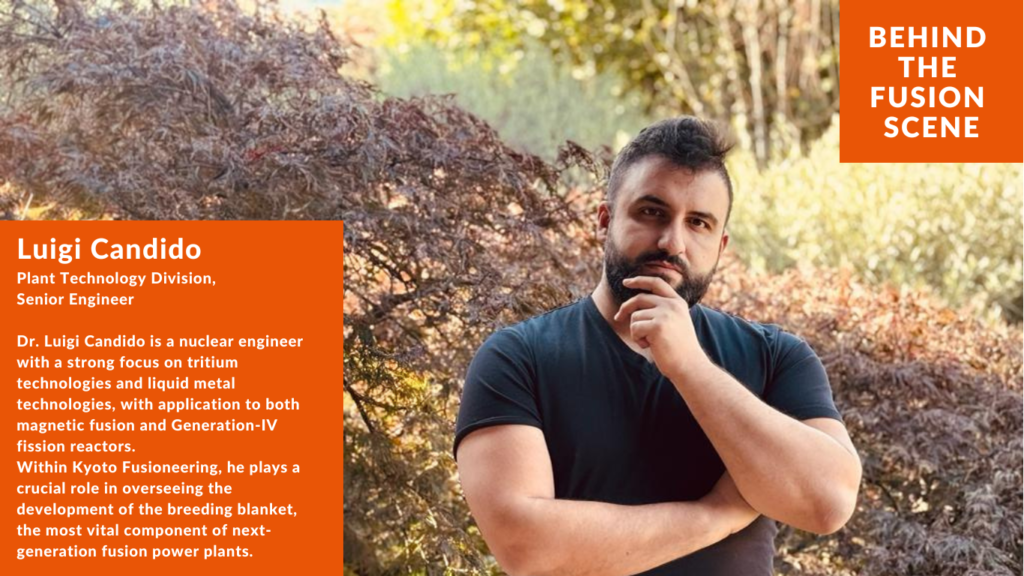
In a nutshell:
Luigi’s professional activity finds its collocation in thermonuclear fusion reactors and Generation-IV fission reactors, more specifically in the framework of high-temperature liquid metals and molten salts, of tritium technologies and in the development of high/ultra-high vacuum techniques. He earned his BS and MSc in Energy and Nuclear Engineering from Polytechnic University of Turin, Italy. He spent seven years between his academia and the National Agency for New Technologies, Energy, and Sustainable Economic Development (ENEA), where he was involved in both modelling and experimental activities. After completing his Ph.D. in Nuclear Power Plants, Luigi joined Fusion for Energy (F4E) and worked in the frame of the Test Blanket Module (TBM) Programme, being the project officer in charge of the development of different sub-systems of the two European TBMs to be tested in ITER (International Thermonuclear Experimental Reactor). During his career, Luigi was involved in international collaborations with some of the major universities and research centres, among which UCLA, MIT (Massachusetts Institute of Technology), Kyoto University, CIEMAT, CEA and KIT, leading Luigi to be author of 40+ scientific publications in international peer-reviewed journals. His extensive experience and dedication to fusion technology make him a key player in advancing clean and sustainable energy solutions.
What motivated you to join Kyoto Fusioneering and pursue a career in the field of fusion energy?
The primary motivation behind my decision to join Kyoto Fusioneering (KF) was its pragmatic vision and its mission to accelerate the realisation of fusion energy. Moreover, the professional profile requested was in perfect alignment with my technical skills and career aspirations. It was tailor-made for me. I have a deep passion for tritium and liquid metal technologies, both of which play pivotal roles in fusion power plants, and KF is the best place to exploit my passions.
Furthermore, I was drawn to KF by the opportunity to make a tangible contribution to the development of fusion energy. Given the complex timelines associated with the ITER project, this presented a chance for me of being part of that accelerating process which could lead to fusion in the mid-term. I am excited to be part of this endeavour, which offers a unique platform to work on the research and development aspects, particularly in the field of blanket development.
What projects are you currently working on KF?
I am leading the project related to the conceptual design of the KF’s blanket, using Self-Cooled Yuryo Lithium-Lead Advanced (SCYLLA©) – yuryo means “superior” in Japanese!). The design is constituted by a self-cooled lithium-lead blanket, which uses lithium-lead with the dual function of tritium breeder and coolant and silicon carbide composite (SiCf/SiC) as structural material. What makes this design truly groundbreaking is the possibility to reach extremely hot temperature at the blanket outlet, setting it apart from traditional concepts and opening new scenarios in terms of hydrogen production and decarbonisation. My responsibilities consist in guiding KF’s engineering team from the pre-conceptual design developed during the last couple of years to a more consolidated, conceptual design of this breeding blanket. We are taking an integrated approach to the design, encompassing all the most critical faces. This includes mechanical design, computational-fluid-dynamics simulations, magneto-hydrodynamics, neutronics analyses, tritium modelling, RAMI assessment. The leit motiv of all these activities is the safety, whose principles are embedded into the design from the scratch. Our aim is to craft a holistic blanket design that covers all necessary activities, paving the way for the subsequent engineering design phase.
We are crafting a versatile blanket design methodology that could potentially adapt to a variety of fusion concepts in the future. In addition to this, I am actively engaged in a significant, long-term objectives definition for fusion-related projects based in the UK. This underscores our unwavering commitment to pioneering clean energy solutions and continuous research and innovation.
My current task is devoted to R&D to increase the technology readiness level of our technologies and in general of fusion technologies. This will be carried out in UNITY-1 and in UNITY-2 facilities. My contributions to the UNITY (Unique Integrated Testing Facility) program also include safety aspects within the field of fusion research. Safety is paramount, and we are dedicated to ensuring that fusion energy technologies not only push the boundaries of innovation but also uphold the highest safety standards. Our close collaboration with experts and organizations in this domain reinforces our commitment to safety.
What is KF doing to commercialize fusion and what is your role in the company in shaping that goal?
At KF, our primary goal is to accelerate the realisation of fusion energy. We are actively working on advancing critical technological components essential for fusion. Among these, the breeding blanket holds a central position. It is not just about commercialisation; it is about achieving the larger objective of making fusion power a reality.
The breeding blanket is a pivotal element within a fusion reactor, responsible to produce tritium, a fundamental fuel for fusion reactions. Tritium is generated within the blanket, specifically inside the so-called breeder material, which in our case is the lithium-lead. The lithium-lead loop and the tritium extraction system are ancillary systems employed, among other functions, to circulate the liquid metal where tritium is solubilised and to extract it, respectively. These aspects will be tested in UNITY-1 facility, in Japan, whose aim is indeed to test the thermal cycle and the power conversion cycle of the breeding blanket system. Once tritium is extracted, it must be efficiently recovered and reintroduced into the vacuum chamber to sustain the fusion reactions.
The tritium fuel cycle, or better, the deuterium-tritium fuel cycle, is of paramount importance. If deuterium is quite abundant, this is not true for tritium, because it is radioactive with a short half-life of 12.32 years. Presently, tritium availability worldwide ranges from 20 to 30 kilograms, while a 2 GWth fusion power plant necessitates around 112 kilograms per year of tritium for effective operation (considering a full-power operation). The substantial gap between tritium availability and demand underscores the necessity of producing tritium within the breeding blanket (thanks to the presence of lithium), ensuring its efficient recovery and reducing as much as possible the losses through the different systems, subsystems, and components.
Within this context, it appears clear that one of the most challenging issues in terms of feasibility and attractiveness in the development of fusion power plants is constituted by the fuel cycle. Starting from its extraction from the liquid lithium-lead, tritium is processed, recovered, and prepared for its reintroduction into the vacuum chamber. To validate the feasibility of the different technologies involved, we are building – in collaboration with the Canadian Nuclear Laboratories (CNL) – UNITY-2. This plant will provide invaluable insights into our capability of tritium storage, fuelling, exhaust management, fuel clean-up and processing systems.
At KF, our mission is to accelerate the development of these key technologies, paving the way for a sustainable and commercially viable fusion energy future.
How is the experience at KF helping you grow in skills & opportunities?
My experience at KF has been instrumental in fostering both my skills and opportunities for growth. The standout aspect is the organization’s extensive network of international connections and collaborations. This rich network provides a unique platform to enhance skills and competencies, offering valuable exposure to diverse perspectives from individuals worldwide.
These collaborations are not limited to public research activities but also encompass private companies, making it a particularly enriching experience. This international network has significantly contributed to my skill development, fostering competencies, analytical thinking, and much more. KF’s global outreach has been an invaluable resource for personal and professional growth.
Your perspective for the future of fusion. What do you want to achieve in KF?
In terms of the future of fusion, my ultimate aspiration, which aligns with the broader fusion community, is to see fusion energy become a reality. This dream encompasses the establishment of a commercial power plant capable of generating electricity, thereby contributing significantly to the global reduction of emissions, a challenge the world is currently facing.
Now, focusing on my role within KF, I aim to grow from my actual role up to the role of chief engineer, which involves a transversal understanding of all most important fusion topics and a much higher level of responsibility. Of course, this will require different steps, but I am working hard on them, and I hope to reach this professional and personal objective inside KF.




